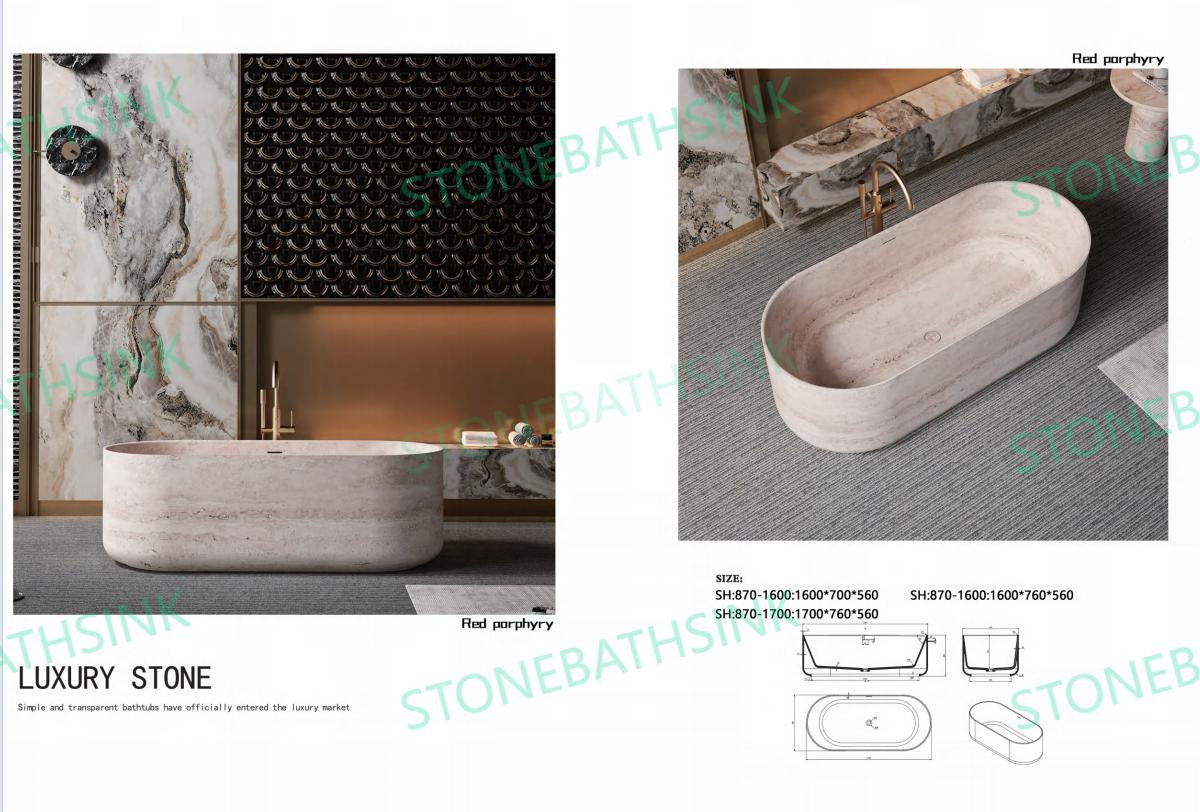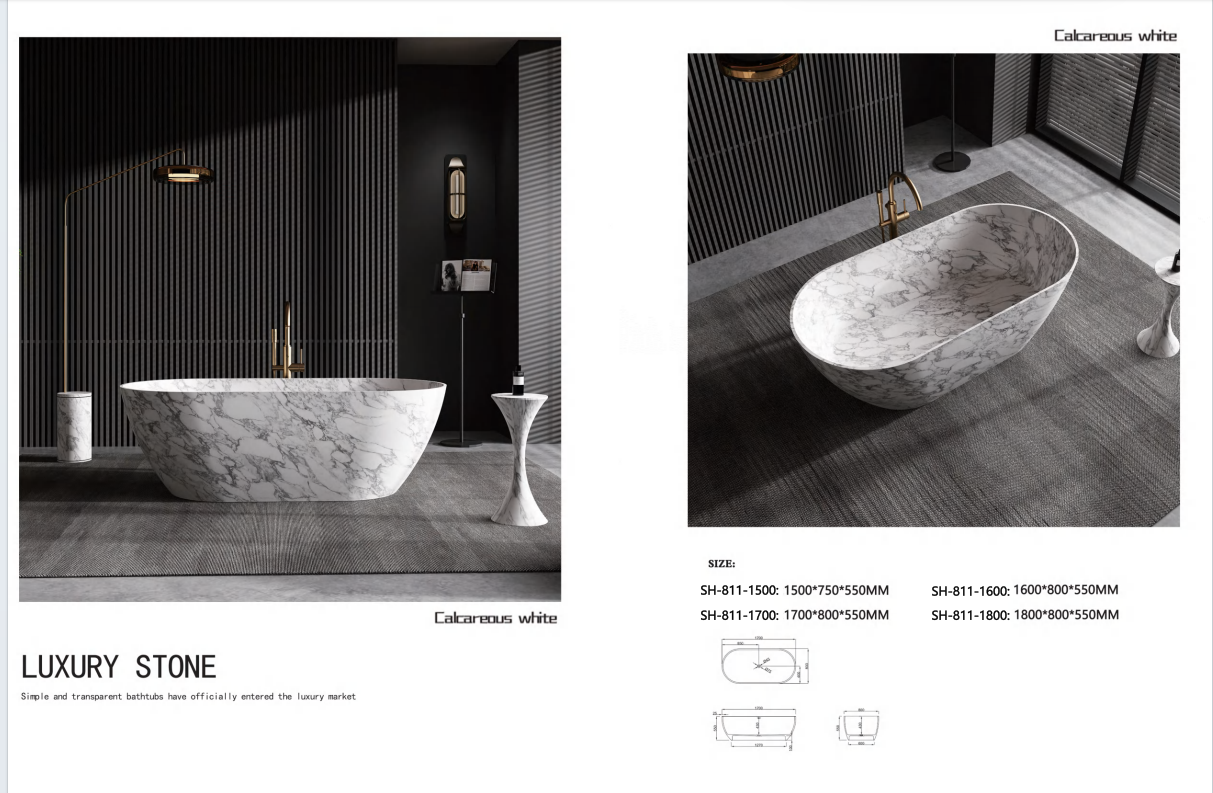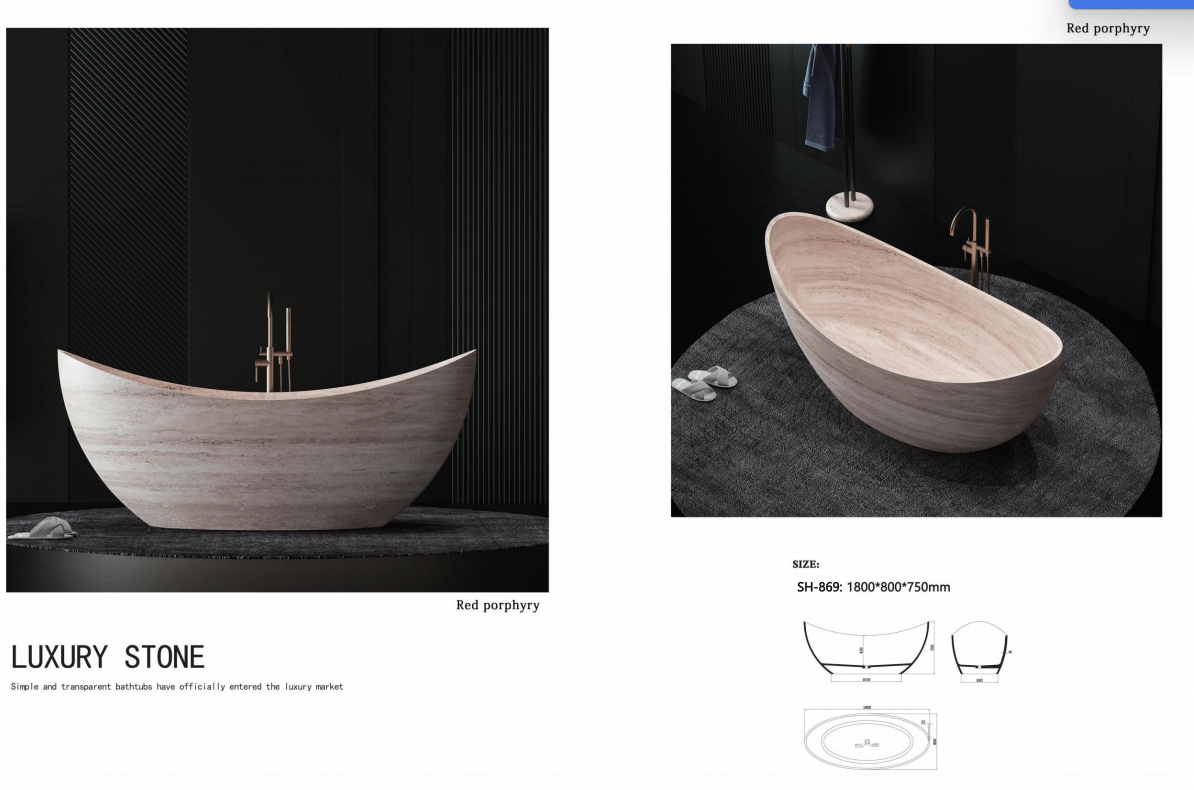marmurowa wanna
Trawertyn to skała osadowa utworzona z akumulacji złóż węglanu wapnia, często w środowiskach gorących źródeł lub jaskiń wapiennych. Ma porowatą teksturę z widocznymi otworami i wgłębieniami, które są charakterystyczne dla tego materiału. Otwory te są wynikiem uwięzienia pęcherzyków gazu podczas procesu formowania. Trawertyn występuje w różnych odcieniach ziemi, w tym beżu, opalenizny, brązu i kości słoniowej, co nadaje mu ciepły i zachęcający wygląd.
4.2 Zalety
Estetyczna atrakcyjność wanien trawertynowych tkwi w ich naturalnym, ziemistym wyglądzie. Mogą stworzyć ciepłą i przytulną atmosferę w łazience, przypominającą naturalne spa lub rustykalne schronienie. Trawertyn jest również stosunkowo lekkim materiałem w porównaniu do marmuru i granitu, co może ułatwić instalację i obniżyć jej koszty.
Podobnie jak marmur i granit, trawertyn ma pewne właściwości zatrzymywania ciepła, zapewniając komfortową temperaturę kąpieli przez rozsądny okres. Ponadto wanny trawertynowe można dostosować do pewnego stopnia, z opcjami różnych wykończeń, takich jak polerowane, honowane lub bębnowane, aby uzyskać pożądany wygląd.
4.3 Wady

Porowata natura trawertynu jest zarówno błogosławieństwem, jak i przekleństwem. Podczas gdy nadaje materiałowi unikalną fakturę, sprawia również, że trawertyn jest bardzo podatny na plamy. Płyny, brud i zanieczyszczenia mogą łatwo wnikać w pory, pozostawiając uporczywe plamy. Regularne uszczelnianie jest niezbędne do ochrony wanny z trawertynu, a nawet po uszczelnieniu wymaga częstszego czyszczenia i konserwacji w porównaniu z materiałami nieporowatymi, takimi jak akryl.
Miękkość trawertynu oznacza również, że jest on bardziej podatny na uszkodzenia spowodowane ostrymi przedmiotami lub nieostrożnym obchodzeniem się z nim. Odpryski i zarysowania mogą być trudne do naprawienia, a z czasem powierzchnia może stracić połysk, jeśli nie będzie odpowiednio pielęgnowana.
4.4 Projekt i instalacja
Wanny trawertynowe są powszechnie spotykane w stylu wolnostojącym i wpuszczanym. Ich naturalny, teksturowany wygląd sprawia, że są doskonałym wyborem do łazienek o wystroju śródziemnomorskim, rustykalnym lub naturalnym. Podczas instalacji ważne jest, aby upewnić się, że wanna trawertynowa jest odpowiednio uszczelniona przed użyciem. Instalatorzy muszą również uważać, aby nie uszkodzić stosunkowo miękkiej powierzchni podczas procesu instalacji.
5. Porównanie i rozważania
5.1 Porównanie estetyczne
Wanny marmurowe oferują klasyczny, elegancki i luksusowy wygląd dzięki gładkim powierzchniom i charakterystycznym żyłkom. Są idealne do tworzenia ekskluzywnej, wyrafinowanej atmosfery łazienki. Z drugiej strony wanny granitowe mają bardziej surowy i naturalny wygląd, dodając ziemistej elegancji, która może pasować do różnych stylów projektowania. Wanny trawertynowe wnoszą ciepły, rustykalny urok dzięki porowatym, teksturowanym powierzchniom i ziemistym tonom, idealne dla tych, którzy chcą bardziej naturalnej łazienki. Ogólne wanny wykonane z materiałów takich jak akryl lub włókno szklane mogą oferować szeroką gamę nowoczesnych i tradycyjnych stylów, ale mogą im brakować naturalnej, ekskluzywnej estetyki naturalnych wanien kamiennych.
5.2 Porównanie trwałości i konserwacji

Wanny granitowe są najbardziej trwałe pod względem odporności na zarysowania, odpryski i trawienie, wymagając najrzadziej konserwacji spośród opcji z naturalnego kamienia. Wanny marmurowe są trwałe, ale wymagają regularnego uszczelniania i ostrożnego obchodzenia się, aby zapobiec uszkodzeniom. Wanny trawertynowe są najbardziej wymagające w utrzymaniu ze względu na ich porowatą naturę, wymagają częstego uszczelniania i czyszczenia, aby uniknąć plam. Ogólne wanny wykonane z akrylu lub włókna szklanego mogą być dość trwałe przy odpowiedniej pielęgnacji, ale mogą być bardziej podatne na pękanie lub zarysowania z czasem w porównaniu z wannami z naturalnego kamienia.
5.3 Porównanie kosztów
Wanny marmurowe są zazwyczaj w wyższej części spektrum cenowego, zarówno pod względem początkowego zakupu, jak i długoterminowych kosztów utrzymania. Wanny granitowe mogą być również drogie, szczególnie w przypadku wysokiej jakości odmian. Wanny trawertynowe są zazwyczaj bardziej przystępne cenowo niż marmurowe i granitowe, ale nadal kosztują więcej niż wiele wanien akrylowych lub z włókna szklanego. Ogólne wanny wykonane z powszechnych materiałów, takich jak akryl lub włókno szklane, są najbardziej przyjaznymi dla budżetu opcjami, co czyni je popularnym wyborem dla osób o ograniczonym budżecie.
5.4 Zagadnienia dotyczące instalacji
Waga wanien marmurowych i granitowych sprawia, że ich instalacja jest bardziej skomplikowana i kosztowna, często wymagając wzmocnienia podłogi i profesjonalnej instalacji. Wanny trawertynowe są lżejsze, ale nadal wymagają ostrożnego obchodzenia się z uwagi na ich miękkość. Ogólnie rzecz biorąc, wanny wykonane z lekkich materiałów, takich jak akryl lub włókno szklane, są najłatwiejsze w instalacji, co może obniżyć koszty instalacji.
Podsumowując, wybór między wanną marmurową, granitową, trawertynową lub wykonaną z innych materiałów zależy od różnych czynników, takich jak osobiste preferencje estetyczne, budżet, pożądany poziom konserwacji i ogólny projekt łazienki. Każdy rodzaj wanny ma swoje własne unikalne cechy, które mogą poprawić wrażenia z kąpieli i wygląd łazienki, co sprawia, że proces wyboru jest ważnym czynnikiem przy tworzeniu idealnego łazienkowego azylu.
2.2 Functionality and Versatility

General bathtubs are designed to meet various needs. They come in different sizes, from small corner tubs suitable for compact bathrooms to large, spacious soaking tubs for those who desire a more luxurious bathing experience. Some bathtubs are equipped with additional features such as jets for hydrotherapy, which can provide a therapeutic massage effect, enhancing relaxation and promoting blood circulation.
The versatility of bathtubs also extends to their installation options. They can be installed as drop - in tubs, where the bathtub is placed into a pre - formed deck; undermount tubs, which are installed beneath the bathroom countertop for a seamless look; or freestanding tubs, which offer more flexibility in bathroom layout and can be positioned anywhere in the room.
3. Granite Bathtub
3.1 Material Properties
Granite is an igneous rock formed from the slow crystallization of magma beneath the Earth's surface. It is composed mainly of quartz, feldspar, and mica, giving it a unique and varied appearance. Granite has a much higher Mohs hardness rating, typically around 6 - 7, making it one of the hardest natural stones used in bathtub manufacturing. This high hardness makes granite extremely resistant to scratching, chipping, and etching.
The color and pattern variations in granite are vast. It can range from solid - colored varieties to those with intricate speckled or swirled patterns. Unlike marble, which has more linear veining, granite's patterns are often more random and diverse, creating a unique and natural look for each bathtub.
3.2 Advantages
The durability of granite bathtubs is one of their most significant advantages. Their resistance to damage means they can withstand the rigors of daily use without showing signs of wear and tear easily. They require minimal maintenance compared to marble bathtubs. While it is still advisable to seal granite periodically, the intervals between sealings can be much longer, sometimes up to several years.
Granite also has excellent heat - retention capabilities, similar to marble, ensuring a warm and comfortable bathing experience. In terms of aesthetics, granite bathtubs offer a more rugged and natural look. They can add a touch of earthy elegance to a bathroom, complementing both traditional and contemporary design styles.
3.3 Disadvantages
One of the main drawbacks of granite bathtubs is their weight. Like marble, granite is a heavy material, which can make installation challenging and costly. The installation process may require special equipment and skilled labor to ensure the bathtub is properly placed and the floor can support its weight.
Another consideration is the cost. Granite bathtubs can be quite expensive, especially if you choose high - quality, rare varieties. Additionally, the rough texture of some granite types may not be as comfortable to lie against as the smoother surface of marble or acrylic bathtubs, although this can be mitigated by choosing a variety with a more refined finish.
3.4 Design and Installation
Granite bathtubs are available in a range of designs, including freestanding, drop - in, and undermount styles. Their natural beauty and durability make them a popular choice for those who want a bathtub that combines functionality with a long - lasting, attractive appearance. During installation, careful planning is required to ensure the structural integrity of the bathroom floor. Professional installers will also take into account the unique shape and weight of the granite bathtub to ensure a secure and level installation.
4. Travertine Tubs
4.1 Material Properties
Travertine is a sedimentary rock formed from the accumulation of calcium carbonate deposits, often in hot spring or limestone cave environments. It has a porous texture, with visible holes and pits that are characteristic of the material. These holes are a result of the gas bubbles that were trapped during the formation process. Travertine comes in a variety of earthy tones, including beige, tan, brown, and ivory, giving it a warm and inviting appearance.
In terms of hardness, travertine has a Mohs hardness rating of around 3 - 4, similar to marble. This makes it relatively soft and prone to scratching and etching. However, its porous nature also means it has a unique, textured surface that can add a rustic and natural charm to a bathroom.
4.2 Advantages
The aesthetic appeal of travertine tubs lies in their natural, earthy look. They can create a warm and cozy atmosphere in the bathroom, reminiscent of a natural spa or a rustic retreat. Travertine is also a relatively lightweight material compared to marble and granite, which can make installation easier and more cost - effective.
Like marble and granite, travertine has some heat - retention properties, providing a comfortable bathing temperature for a reasonable period. Additionally, travertine tubs can be customized to a certain extent, with options for different finishes, such as polished, honed, or tumbled, to achieve the desired look.
4.3 Disadvantages
The porous nature of travertine is both a blessing and a curse. While it gives the material its unique texture, it also makes travertine highly susceptible to staining. Liquids, dirt, and grime can easily penetrate the pores, leaving behind stubborn stains. Regular sealing is essential to protect the travertine tub, and even with sealing, it requires more frequent cleaning and maintenance compared to non - porous materials like acrylic.
The softness of travertine also means it is more likely to be damaged by sharp objects or rough handling. Chips and scratches can be difficult to repair, and over time, the surface may lose its luster if not properly cared for.
4.4 Design and Installation
Travertine tubs are commonly found in freestanding and drop - in styles. Their natural, textured appearance makes them a great choice for bathrooms with a Mediterranean, rustic, or natural - themed design. During installation, it is important to ensure that the travertine tub is properly sealed before use. Installers also need to be careful not to damage the relatively soft surface during the installation process.
5. Comparison and Considerations
5.1 Aesthetic Comparison
Marble bathtubs offer a classic, elegant, and luxurious look with their smooth surfaces and distinctive veining. They are perfect for creating a high - end, sophisticated bathroom atmosphere. Granite bathtubs, on the other hand, have a more rugged and natural appearance, adding an earthy elegance that can suit a variety of design styles. Travertine tubs bring a warm, rustic charm with their porous, textured surfaces and earthy tones, ideal for those who want a more natural - feeling bathroom. General bathtubs made from materials like acrylic or fiberglass can offer a wide range of modern and traditional styles, but may lack the natural, high - end aesthetic of natural stone bathtubs.
5.2 Durability and Maintenance Comparison
Granite bathtubs are the most durable in terms of resistance to scratching, chipping, and etching, requiring the least frequent maintenance among the natural stone options. Marble bathtubs are durable but demand regular sealing and careful handling to prevent damage. Travertine tubs are the most maintenance - intensive due to their porous nature, needing frequent sealing and cleaning to avoid staining. General bathtubs made from acrylic or fiberglass can be quite durable with proper care, but they may be more prone to cracking or scratching over time compared to natural stone bathtubs.
5.3 Cost Comparison
Marble bathtubs are generally on the higher end of the price spectrum, both in terms of the initial purchase and long - term maintenance costs. Granite bathtubs can also be expensive, especially for high - quality varieties. Travertine tubs are usually more affordable than marble and granite but still cost more than many acrylic or fiberglass bathtubs. General bathtubs made from common materials like acrylic or fiberglass are the most budget - friendly options, making them a popular choice for those on a tight budget.
5.4 Installation Considerations
The weight of marble and granite bathtubs makes their installation more complex and costly, often requiring floor reinforcement and professional installation. Travertine tubs are lighter but still need careful handling due to their softness. General bathtubs made from lightweight materials like acrylic or fiberglass are the easiest to install, which can save on installation costs.
In conclusion, the choice between a marble bathtub, granite bathtub, travertine tub, or a bathtub made from other materials depends on various factors such as personal aesthetic preferences, budget, desired level of maintenance, and the overall design of the bathroom. Each type of bathtub has its own unique qualities that can enhance the bathing experience and the look of the bathroom, making the selection process an important consideration in creating the perfect bathroom retreat.
